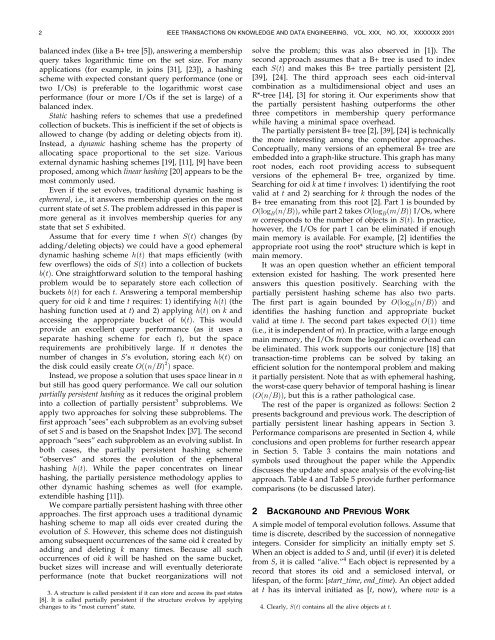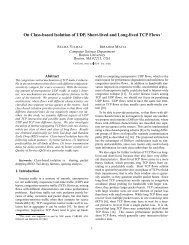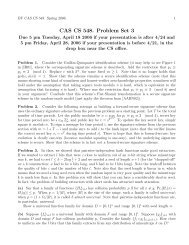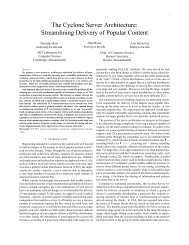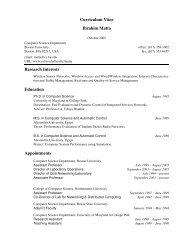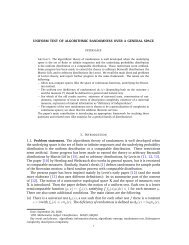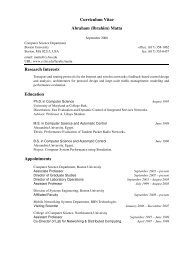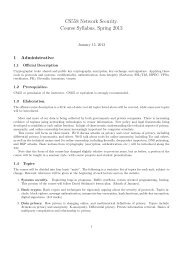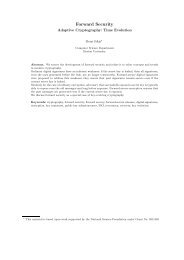Hashing Methods for Temporal Data - Computer Science - Boston ...
Hashing Methods for Temporal Data - Computer Science - Boston ...
Hashing Methods for Temporal Data - Computer Science - Boston ...
Create successful ePaper yourself
Turn your PDF publications into a flip-book with our unique Google optimized e-Paper software.
2 IEEE TRANSACTIONS ON KNOWLEDGE AND DATA ENGINEERING, VOL. XXX, NO. XX, XXXXXXX 2001<br />
balanced index like a B+ tree [5]),answering a membership<br />
query takes logarithmic time on the set size. For many<br />
applications <strong>for</strong> example,in joins [31],[23]),a hashing<br />
scheme with expected constant query per<strong>for</strong>mance one or<br />
two I/Os) is preferable to the logarithmic worst case<br />
per<strong>for</strong>mance four or more I/Os if the set is large) of a<br />
balanced index.<br />
Static hashing refers to schemes that use a predefined<br />
collection of buckets. This is inefficient if the set of objects is<br />
allowed to change by adding or deleting objects from it).<br />
Instead,a dynamic hashing scheme has the property of<br />
allocating space proportional to the set size. Various<br />
external dynamic hashing schemes [19],[11],[9] have been<br />
proposed,among which linear hashing [20] appears to be the<br />
most commonly used.<br />
Even if the set evolves,traditional dynamic hashing is<br />
ephemeral,i.e.,it answers membership queries on the most<br />
current state of set S. The problem addressed in this paper is<br />
more general as it involves membership queries <strong>for</strong> any<br />
state that set S exhibited.<br />
Assume that <strong>for</strong> every time t when S…t† changes by<br />
adding/deleting objects) we could have a good ephemeral<br />
dynamic hashing scheme h…t† that maps efficiently with<br />
few overflows) the oids of S…t† into a collection of buckets<br />
b…t†. One straight<strong>for</strong>ward solution to the temporal hashing<br />
problem would be to separately store each collection of<br />
buckets b…t† <strong>for</strong> each t. Answering a temporal membership<br />
query <strong>for</strong> oid k and time t requires: 1) identifying h…t† the<br />
hashing function used at t) and 2) applying h…t† on k and<br />
accessing the appropriate bucket of b…t†. This would<br />
provide an excellent query per<strong>for</strong>mance as it uses a<br />
separate hashing scheme <strong>for</strong> each t),but the space<br />
requirements are prohibitively large. If n denotes the<br />
number of changes in S's evolution,storing each b…t† on<br />
the disk could easily create O……n=B† 2 † space.<br />
Instead,we propose a solution that uses space linear in n<br />
but still has good query per<strong>for</strong>mance. We call our solution<br />
partially persistent hashing as it reduces the original problem<br />
into a collection of partially persistent 3 subproblems. We<br />
apply two approaches <strong>for</strong> solving these subproblems. The<br />
first approach "sees" each subproblem as an evolving subset<br />
of set S and is based on the Snapshot Index [37]. The second<br />
approach ªseesº each subproblem as an evolving sublist. In<br />
both cases,the partially persistent hashing scheme<br />
ªobservesº and stores the evolution of the ephemeral<br />
hashing h…t†. While the paper concentrates on linear<br />
hashing,the partially persistence methodology applies to<br />
other dynamic hashing schemes as well <strong>for</strong> example,<br />
extendible hashing [11]).<br />
We compare partially persistent hashing with three other<br />
approaches. The first approach uses a traditional dynamic<br />
hashing scheme to map all oids ever created during the<br />
evolution of S. However,this scheme does not distinguish<br />
among subsequent occurrences of the same oid k created by<br />
adding and deleting k many times. Because all such<br />
occurrences of oid k will be hashed on the same bucket,<br />
bucket sizes will increase and will eventually deteriorate<br />
per<strong>for</strong>mance note that bucket reorganizations will not<br />
solve the problem; this was also observed in [1]). The<br />
second approach assumes that a B+ tree is used to index<br />
each S…t† and makes this B+ tree partially persistent [2],<br />
[39],[24]. The third approach sees each oid-interval<br />
combination as a multidimensional object and uses an<br />
R*-tree [14],[3] <strong>for</strong> storing it. Our experiments show that<br />
the partially persistent hashing outper<strong>for</strong>ms the other<br />
three competitors in membership query per<strong>for</strong>mance<br />
while having a minimal space overhead.<br />
The partially persistent B+ tree [2],[39],[24] is technically<br />
the more interesting among the competitor approaches.<br />
Conceptually,many versions of an ephemeral B+ tree are<br />
embedded into a graph-like structure. This graph has many<br />
root nodes,each root providing access to subsequent<br />
versions of the ephemeral B+ tree,organized by time.<br />
Searching <strong>for</strong> oid k at time t involves: 1) identifying the root<br />
valid at t and 2) searching <strong>for</strong> k through the nodes of the<br />
B+ tree emanating from this root [2]. Part 1 is bounded by<br />
O…log B …n=B††,while part 2 takes O…log B …m=B†† I/Os,where<br />
m corresponds to the number of objects in S…t†. In practice,<br />
however,the I/Os <strong>for</strong> part 1 can be eliminated if enough<br />
main memory is available. For example,[2] identifies the<br />
appropriate root using the root* structure which is kept in<br />
main memory.<br />
It was an open question whether an efficient temporal<br />
extension existed <strong>for</strong> hashing. The work presented here<br />
answers this question positively. Searching with the<br />
partially persistent hashing scheme has also two parts.<br />
The first part is again bounded by O…log B …n=B†† and<br />
identifies the hashing function and appropriate bucket<br />
valid at time t. The second part takes expected O…1† time<br />
i.e.,it is independent of m). In practice,with a large enough<br />
main memory,the I/Os from the logarithmic overhead can<br />
be eliminated. This work supports our conjecture [18] that<br />
transaction-time problems can be solved by taking an<br />
efficient solution <strong>for</strong> the nontemporal problem and making<br />
it partially persistent. Note that as with ephemeral hashing,<br />
the worst-case query behavior of temporal hashing is linear<br />
…O…n=B††,but this is a rather pathological case.<br />
The rest of the paper is organized as follows: Section 2<br />
presents background and previous work. The description of<br />
partially persistent linear hashing appears in Section 3.<br />
Per<strong>for</strong>mance comparisons are presented in Section 4,while<br />
conclusions and open problems <strong>for</strong> further research appear<br />
in Section 5. Table 3 contains the main notations and<br />
symbols used throughout the paper while the Appendix<br />
discusses the update and space analysis of the evolving-list<br />
approach. Table 4 and Table 5 provide further per<strong>for</strong>mance<br />
comparisons to be discussed later).<br />
2 BACKGROUND AND PREVIOUS WORK<br />
A simple model of temporal evolution follows. Assume that<br />
time is discrete,described by the succession of nonnegative<br />
integers. Consider <strong>for</strong> simplicity an initially empty set S.<br />
When an object is added to S and,until if ever) it is deleted<br />
from S,it is called ªalive.º 4 Each object is represented by a<br />
record that stores its oid and a semiclosed interval,or<br />
lifespan,of the <strong>for</strong>m: [start_time, end_time). An object added<br />
at t has its interval initiated as [t,now),where now is a<br />
3. A structure is called persistent if it can store and access its past states<br />
[8]. It is called partially persistent if the structure evolves by applying<br />
changes to its ªmost currentº state. 4. Clearly, S…t† contains all the alive objects at t.


